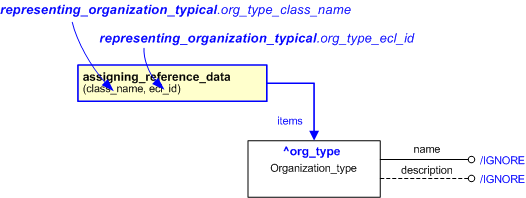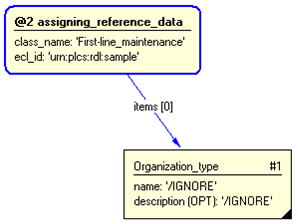| Template:— representing_organization_typical (rep_org_typ) |
Date: 2008/02/27 16:39:46
Revision: 1.10
|
This section specifies the template representing_organization_typical.
NOTE
An explanation of a template and the associated instantiation path is
provided in the
Template overview
section.
This template describes how to represent a type of organization, e.g. line of maintenance.
The EXPRESS-G diagram in
Figure
1
shows the templates and EXPRESS entities that are required
to represent the template
"representing_organization_typical".
The text highlighted in blue shows the template parameters.
Figure 1 — An EXPRESS-G representation of the Information model for representing_organization_typical
The graphic for the template to be used in other EXPRESS-G diagrams
is shown in Figure
2
below.
Figure 2 — The graphical representation of the representing_organization_typical template
The following input parameters are defined for this template:
The name of the
External_class that determines the organization type being referenced.
The following classes and their sub-classes can be used:
The following reference parameters are defined for this template:
Allow the
Organization_type
entity instantiated in this path to be referenced when this template is used.
%^target = $representing_organization_typical.org_type%
The following parameter combinations specify a uniqueness constraint:
Unique constraint: Organization type
There shall be at most one instance of the
entity
(
Organization_type)
within the data set uniquely identified
by a combination of the following parameters on this
template (representing_organization_typical) namely:
org_type_class_name,
org_type_ecl_id.
The
instance is
referenced by the following template parameter:
org_type.
The instantiation path shown below specifies the entities that are to be
instantiated by the template.
The following entities are instantiated with attributes as specified:
The instance diagram in Figure
3
shows an example of the EXPRESS entities and templates that are instantiated by the template:
/representing_organization_typical(org_type_class_name='First-line_maintenance', org_type_ecl_id='urn:plcs:rdl:sample')/
(an illustration of the consolidated representing_organization_typical template is shown in
Figure
4 below.)
Figure 3 — Entities instantiated by representing_organization_typical template
The instance model in STEP ASCII exchange file format (ISO 10303 Part
21 syntax) is:
#1 = ORGANIZATION_TYPE('/IGNORE','/IGNORE');
#3 = CLASSIFICATION_ASSIGNMENT(#5,(#1),'/IGNORE');
#5 = EXTERNAL_CLASS('/NULL','First-line_maintenance','/IGNORE',#6);
#6 = EXTERNAL_CLASS_LIBRARY('urn:plcs:rdl:sample',$);
The instance diagram in
Figure
4
shows the graphic symbol for the template that is to be
used in other instance diagrams. The example template is:
/representing_organization_typical(org_type_class_name='First-line_maintenance', org_type_ecl_id='urn:plcs:rdl:sample')/
Figure 4 — Instantiation of representing_organization_typical template
The following section details how the
representing_organization_typical
template can be optionally characterized by assigning
other constructs to it. These are characterizations commonly
applied to the template. The ISO 10303-239 EXPRESS model may enable
other assignments to the entities instantiated by the template.
The following characterizations may apply:
Characterization Assigning descriptor
NOTE this characterization is optional.




